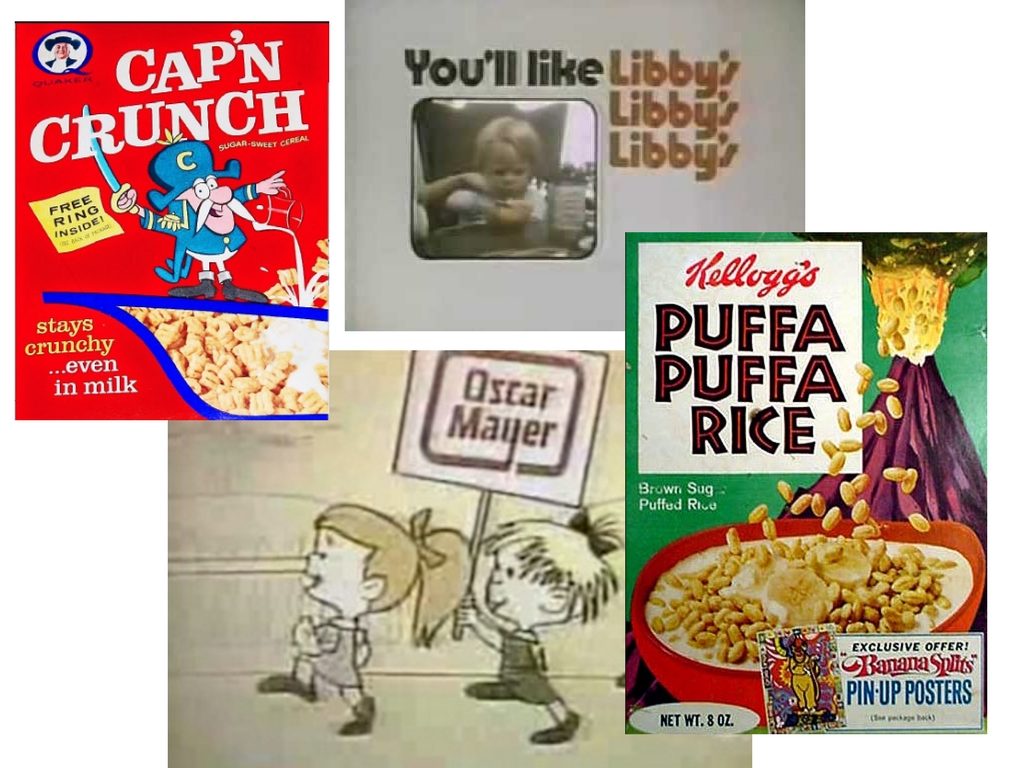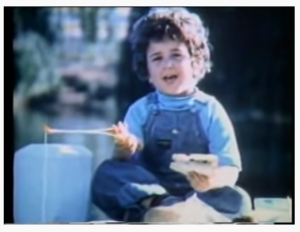
Forty years is a long time for a brand — primarily through print packaging and some silly songs — to sustain a consumer’s attention and loyalty. It hardly seems possible.
Yet the print packaging of my husband’s childhood is what guides him, to this day, through the aisles of the grocery store. He does his grocery shopping solely based on the colors of the packaging and the logos of his youth.
- Orange box, Wheaties.
- Red can, Coca Cola.
- Blue box, Philadelphia cream cheese.
- Red and white can, Campbell’s soup.
- Green label, Wishbone salad dressing.
He calls to me from the kitchen: “Where’s the box of Lucky Charms?”
They’re not Lucky Charms anymore, hon. And they’re not Magically Delicious. They’re the bland budget brand in a pillow size plastic bag, rolled up and closed with a clip. They’re not in a colorful box, easy to identify, triggering the cereal jones. They’re invisible without their pink hearts, yellow moons, orange stars and green clovers.
My husband sighs, disappointed. “They’re always after me Lucky Charms!”
You see, we were kids in the 1970s.
Grocery stores had very little space devoted to fruits and vegetables. We bought meat at the butcher’s shop. The milkman brought the milk and ice cream. Everything else was canned or boxed, and we knew all the products by brand name, packaging, and logo.
And jingles. We knew all the advertising jingles!
In our parallel childhoods, my husband and I sang along with the commercials on TV, “When it says Libby’s, Libby’s, Libby’s on the label, label, label. You will like it, like it, like it, on your table, table, table….”
We knew the jingles for Oreos (“Do you know exactly how to eat an Oreo? Well, to do it, you unscrew it…very fast!”), Jolly Green Giant (“Ho, ho, ho!”), Oscar Meyer (“Oh, I wish I were an Oscar Meyer Wie-e-e-e-e-ner!”), Big Macs (“two all beef patties”), and Jello (“J-E-L-L-Oh!”). We’d sing them at the tops of our lungs while we walked to school.
We can still sing them.
We would beg our parents for cereal brands, drilled into us by Saturday morning television, and identify them on the shelves by the color of the box.
- Brown box: Cocoa Puffs!
- Red box: Cap’n Crunch!
- Green box: Apple Jack’s!
- White box: Life, because Mikey likes it!
Things got more complicated once I started driving.
My mom gave me $50 a week to do the grocery shopping for the family. Any money that was left was mine to keep. I started shopping at the farmer’s markets to save money. The compulsion to buy TV brands melted away in favor of price, value and quality.
My husband, on the other hand, never had to shop on a budget. He never saw how different packaging of the same product could easily cost twice as much. He just knew he liked it then…and he likes it now.
Print’s role in this story is a sustaining one.
Even though today’s grocery stores carry more fresh food than ever before, we rely on print and branding to navigate our way through a shopping trip.
My friends who eschew grocery stores and grow their own food will still buy soap, toothpaste, toilet paper, and other supplies. Often they choose the luxury brands or those with the most convincing environmental message. They’re still making choices based on brand messaging and print packaging.
As I look at the shopping habits of my children, I see them making choices based on the input of movie stars, musicians , sports stars, and social media influencers.
Mostly they buy what their friends buy.
Print influenced our generation. Will it influence our kids?
Will they will carry brand loyalty forward into adulthood, or will it be as transitory as the media they consume?
Will printed packaging of the future still appeal to our basest shopping impulses, or will it serve a completely different role?
Will our kids will be able to remember the jingles of their childhood? I hope so. Because at the end of the day when my brain is on overload, I can still sing “My balogna has a first name…. It’s O-S-C-A-R!”

Advertisers are missing an opportunity with memorable print packaging mixed with catchy jingles, aren’t they? What are your favorite product jingles from your childhood? Share in the comments below.
 Sandy Hubbard is a marketing strategist for printing companies. She builds marketing programs that can be sustained over the long haul, with affordable tools and your own people…and without stress! Find @sandyhubbard on Twitter each Wednesday at 4 PM ET, assisting #PrintChat host Deborah Corn @PrintMediaCentr with a lively online discussion for printers and those who love print.
Sandy Hubbard is a marketing strategist for printing companies. She builds marketing programs that can be sustained over the long haul, with affordable tools and your own people…and without stress! Find @sandyhubbard on Twitter each Wednesday at 4 PM ET, assisting #PrintChat host Deborah Corn @PrintMediaCentr with a lively online discussion for printers and those who love print.












12 Responses
I enjoyed this article, and I would have enjoyed it even more if it had been proof-read before publishing !
Thanks, Phyllis – I appreciate your comment, and am always happy when an eagle eye catches things. I’ll go back and tidy up! Thanks again 🙂
Excellent post Sandy and it brought back a few memories for me too!
And yikes Phyllis Potter! That’s your contribution to the comments?
Thanks, Paul, for sharing my post on LinkedIn. It’s so fun to look at photos of products from my childhood, especially retail packaging. We should collaborate on a flashback post!
Great read Sandy! Now I want some Honey Nut Cheerios!
Did ANYBODY actually like Quisp and Quake? I still sneak Fruit Loops now and then — it’s fruit! And it’s good for you! They’re picked that way right off the tree! I knew Arthur Anderson, NY radio/TV/theater/film actor, who in his old age became the voice of Lucky, the leprechaun, in the Lucky Charms commercials, which was a nice supplemental paycheck for him for a couple of decades. The tie-in with the TV ads and packaging was critical. They were magically delicious in the ad, and that had to be conveyed on the shelf. Cross-media didn’t start in the 1990s — it was always there, and packaging was a critical part of it — and those brands make for some great memories! (And I remember when they were called Sugar Pops, not Corn Pops!). And it will be even more interesting when ePaper is used to provide animation on fronts of packages — it can happen!
I LOVED QUISP!!!!
Thanks for the blast to the past, Dr. Joe – and you are right, cross marketing and promotion was a huge part of cereal brands’ success. I miss the jingles, though!
Great Post! Thank you for the romp down Memory Lane. Coming in at the tail end of the Baby Boom my wife and I are advertising junkies. Packaging, Radio and TV prompts from back in the day will launch us into song belting out cereal, beer and yes, cigarette ads from our youth. Yes, those brands owned us, and we were glad of it.
Thanks, Jon! We advertising junkies are loud and proud!
Interesting post Sandy.
The advertising and marketing for these well known branded products comes at a price though – usually to the consumer!
Branded cereal in my local supermarket can cost £2 per box, whilst the unbranded, no-frills version can cost just £0.50 for an almost identical product. Until recently, I would choose on brand over price.
As the consumer tends to move towards online purchases, I wonder if the same printed marketing trends will work the same for e-products?
No doubt that the branding of years gone by did an amazing job of putting TV jingles in our heads and associating them with the printed brands that still exist today. They are few and far between these days.
Good insight about the evolution of packaging, food prices and markups, and the challenge of how products will differentiate themselves online in a two-dimensional world. Meanwhile, print just keeps getting sexier! Print has awesome interactive possibilities, dimensional effects, metallic inks and foils, expanded gamut colors, die cuts, embossing and more. I hope packaging experts keep pulling cool things out of their bag of tricks so I don’t have to buy the bag of cereal with the generic “X” on it! I appreciate your comment! –sandy